Most of the signs you’ll see on our roads are international symbolic signs. This means they use the same shapes and symbols as traffic signs all over the world.
Symbolic signs are used because they’re quick and easy to read and understand.
The signs are generally made of reflective material, making them easier to read at night.
The signs on our roads can be divided into 3 types:
You must be able to recognise and understand each type of sign.
Some examples of these signs are shown below.
Note: the examples are only a small sample of the symbolic signs used on our roads. This is to familiarise you with the 3 main types of sign rather than show you all the signs you’ll see when driving.
Compulsory signs tell you what you must or must not do. They’re usually red or blue.
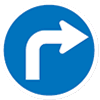
Turn right

Keep going straight ahead

Keep left

You must not go faster than 50km/h

You must not drive into this road

You must not turn left

You must not make a U-turn

You must stop and then give way

You must slow down and give way (or stop, if necessary)

School patrol – you must stop
Some compulsory signs have red borders.

You must keep left unless passing

Bus lane that can also be used by cycles, motorcycles, mopeds

Bus lane that can only be used by buses

Transit lane – can only be used by passenger service vehicles, cycles, motorcycles, mopeds and vehicles carrying at least the number of people shown on the sign. T2 means 2 or more people, T3 means 3 or more.
Important!Road authorities, such as local councils, may have special rules for road users in specific areas. These restrictions should be shown by signs or markings. |
Warning signs alert you to a hazard on the road ahead. They warn you to be careful for your own safety, the safety of other road users or the safety of road workers carrying out maintenance.
There are 2 types of warning signs:
Both types of sign are usually diamond shaped.
These warning signs are yellow and black.

Pedestrian crossing

Look out for children
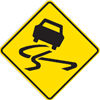
Slippery surface

Road narrows

Clearance height advance warning
These warning signs are orange and black.
 Roadworks
Roadworks
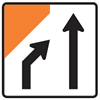 Left lane closed
Left lane closed
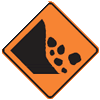 Slips
Slips
 Gravel surface
Gravel surface
 Stop on request
Stop on request

Other hazard


You may also see some signs in both te reo Māori and English.
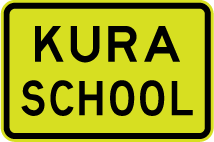
Kura school sign
These signs give you useful information, for example, the distance to the next town. They’re all rectangular, but come in a range of different colours and sizes.
 You may turn left, but first give way to any
You may turn left, but first give way to any
pedestrians and vehicles

Shows the state highway number and the
distance in kilometres to places listed
 Shows directions to places
Shows directions to places
at the next intersection
 Shows the way to the nearest
Shows the way to the nearest
information centre
![]() Shows the state highway number
Shows the state highway number
and direction to places listed

Temporary information sign – roadworks or
construction site access 100 metres ahead